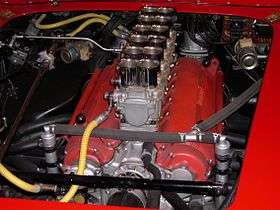Weber carburetor
Weber is an Italian company which produces carburetors; it is owned by LCN.[1]
| Industry | Automotive industry |
|---|---|
| Founded | 1923 |
| Defunct | 1992 |
| Headquarters | Italy |
Area served | Worldwide |
| Parent | Magneti Marelli |

History
Eduardo Weber began his automotive career working for Fiat, first at their Turin plant (in 1914) and later at a dealership in Bologna. After the war, with gasoline prices high, he reached a certain success in selling conversion kits for running trucks on kerosene instead.[2] The company was established as Fabbrica Italiana Carburatori Weber in 1923 when Weber produced carburetors as part of a conversion kit for Fiats. Weber pioneered the use of two-stage twin-barrel carburetors, with two venturis of different sizes (the smaller one for low-speed running and the larger one optimised for high-speed use).
In the 1930s, Weber began producing twin-barrel carburetors for motor racing, where two barrels of the same size were used. These were arranged so that each cylinder of the engine had its own carburetor barrel. These carburetors found use in Maserati and Alfa Romeo racing cars. Twin updraft Weber carburetors fed superchargers on the 1938 Alfa Romeo 8C competition vehicles.[3]
Fiat assumed control of the company in 1952 following Weber's disappearance in 1945. In time, Weber carburetors were fitted to standard production cars and factory racing applications from automotive marques such as Abarth, Alfa Romeo, Aston Martin, BMW, Chrysler, Ferrari, Fiat, Ford, IKA, Lamborghini, Lancia, Lotus, Maserati, Morgan, Porsche, Renault, Triumph and Volkswagen.
In 1986, Fiat also took control of Weber competitor Solex, and merged the two into a single company (Raggruppamento Controllo Motore, or the "Engine Management Group"). This was then reorganized as Magneti Marelli Powertrain S.p.A. in 1986.[4] Genuine Weber carburetors were produced in Bologna, Italy, up until 1992, when production was transferred to Madrid, Spain, where they continue to be made today.[2] Actual owner of Weber brand is LCN.[5]
Modern use
In modern times, fuel injection has replaced carburetors in both production cars and most modern motor racing, although Weber carburetors are still used extensively in classic and historic racing. They are also supplied as high-quality replacements for problematic OEM carburetors. Weber fuel system components are distributed by Magneti Marelli, Webcon UK Ltd., and, in North America, by several organizations, including Worldpac, marketing under the Redline name. Other suppliers include Overseas Distributing, Pierce Manifolds & Lynx Weber in Australia
Weber carburetors are sold for both street and off-road use, with the twin-choke sidedraft DCOE (Doppio Corpo Orizzontale E; "Double-Body Horizontal E") being the most common one. They are sold in what is referred to as a Weber conversion kit. A Weber conversion kit is a complete upgrade package consisting of a Weber carburetor, intake manifold or manifold adapter, throttle linkage, air filter, and all of the hardware needed for installation on a vehicle.
Model codes
Weber carburetors are marked with a model code on the mounting flange, the body, or on the cover of the float chamber.[6] This begins with a number which originally indicated the diameter (in millimetres) of the throttle bore, but later lost this significance. If this number has a single pair of digits, both chokes are of the same diameter and operate together; if it has two pairs of digits separated by a stroke (e.g. 28/36), there are primary and secondary chokes that are opened one after the other, usually of differing diameter.[7]
These numbers are followed by a group of letters, which indicate various features: the DCOE is a sidedraft unit, all others being downdraft; the DCD has a piston-type starter valve as opposed to a strangler choke; and so on.[8] After the letters there will be a further number, which may be followed by a letter, e.g. 4B, 13A; these indicate the series.[9] The full designation might be 40 DCOE 29, 45 DCOE 9, etc.[10]
Copies
Nowadays you can find DCOE, IDF or DGV carburetors from other companies, like EMPI or FAJS, usually with half price. Often these are called FAKE[11] by Weber users. Both are manufactured in China and both are 100% copy, so all parts are interchangeable. Operation however may vary from the original.
See also
- List of Italian companies
Notes
- http://www.lcn.es/?lang=en
- LaChance, David (March 2012). "Supply Side: Weber". Hemmings Sports & Exotic Car. Bennington, VT: Hemmings Motor News. 7 (7): 64. ISSN 1555-6867.
- Thompson, Jonathan (September 1964). "Scale Plan Series: 1935-37 8C 35, 12C 36 and 12C 37 Alfa Romeos". Model Car & Track. 1 (6): 30. Retrieved 2012-05-16.
- https://www.magnetimarelli.com/company/history/1980-2000#20
- http://www.lcn.es/?lang=en
- Penberthy, Ian (1988). Thacker, Tony (ed.). How to Restore Fuel Systems and Carburettors. Osprey Restoration Guide. London: Osprey Publishing. p. 84. ISBN 0-85045-784-X. 15.CS1 maint: ref=harv (link)
- Penberthy 1988, pp. 84, 86
- Penberthy 1988, pp. 84, 86, 97
- Penberthy 1988, pp. 86, 96
- Penberthy 1988, p. 95
- https://www.weberperformance.com.au/information.php?info_id=14
References
- Weber Carburettors Owners Workshop Manual, Haynes Publishing, ISBN 0-85696-393-3
- Weber Carburetors, Pat Braden, ISBN 0-89586-377-4
- Weber Tuning Manual, available from Webcon UK Ltd
External links
| Wikimedia Commons has media related to Weber carburetors. |